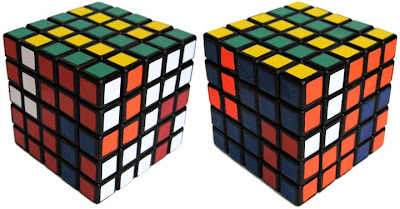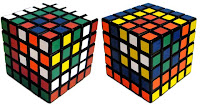

This pattern is a another double-helix like the previous
Twisted DNA with a somewhat ore complicated color scheme. In this instance, the colors on each face are flipped onto each adjacent face. For example, the white face shown above has a green stripe and the adjacent green face has a white stripe. The white face also contains a red stripe, and the adjacent red face also contains a white stripe.
This colo

r scheme extends around the entire cube, as shown at right.
Because the colors are flipped from adjacent faces, all six colors are visible when the cube is viewed diagonally. At left the trio of red-green-blue faces contain stripes in white-orange-yellow. Naturally the white-orange-yellow faces must contain red-green-blue stripes.
I used different color groupings from the previous
Twist ed DNA
ed DNA (which was white-green-orange and red-yellow-blue) because
it provided better color-contrast for this pattern.
Both patterns are best when viewed firsthand because you can trace the double-helix all the way around the cube...


















































